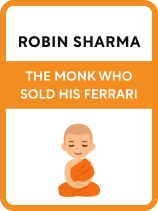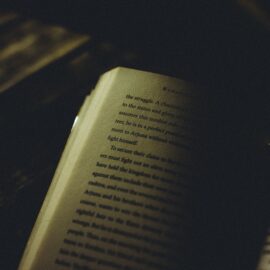

This article is an excerpt from the Shortform book guide to "The Monk Who Sold His Ferrari" by Robin Sharma. Shortform has the world's best summaries and analyses of books you should be reading.
Like this article? Sign up for a free trial here .
What is The Monk Who Sold His Ferrari book about? What are the important lessons from The Monk Who Sold His Ferrari by Robin Sharma?
The Monk Who Sold His Ferrari by Robin Sharma is about simplifying your life and focusing on your purpose. In The Monk Who Sold His Ferrari book, a rich and successful attorney gives everything up and goes on a quest of discovery in India.
Read more about The Monk Who Sold His Ferrari book and the lessons it offers.
The Monk Who Sold His Ferrari Book
The Monk Who Sold His Ferrari book teaches a series of lessons about how to live a simple, fulfilling, and ultimately happy life. The lessons are given in the form of a parable, as Julian—once a wealthy lawyer, now a much poorer but much happier monk—teaches a former colleague named John what he’s learned.
Death and Rebirth
After suffering a heart attack mid-trial, Julian gives up practicing law and travels to India to find meaning and balance in his life. Three years later he comes back fit, happy, and healthier than he’s been in decades. John is amazed by his transformation, and Julian promises to teach his former colleague what he learned during his time away.
The main virtues Julian teaches are caring for your mind, finding a purpose, improving yourself, practicing self-control, managing your time, serving others, and living in the moment. These virtues are introduced by a short fable, which may appear nonsensical at first:
Imagine that you are sitting in a beautiful garden, with a red lighthouse at the center of it. Out of the lighthouse comes an enormous sumo wrestler, who is naked except for a pink wire cable worn as underwear. He finds a gold watch and puts it on, then immediately falls to the ground unconscious. He is soon awakened by the smell of nearby roses and leaps to his feet with renewed energy. He looks to his left and sees a path of diamonds stretching into the distance. He follows the path and it leads him to eternal happiness.
Each of the seven virtues are represented by a metaphor in the story. Most of the rest of The Monk Who Sold His Ferrari book is dedicated to explaining and exploring those metaphors.
Tend the Garden of Your Mind
The beautiful garden is a metaphor for your mind in The Monk Who Sold His Ferrari by Robin Sharma. Just like you have to watch and tend a garden, you should watch and tend the thoughts that you allow into your mind. When you let your garden get polluted with worries and anxieties, you waste your mental energy and can cause serious long-term damage to your creativity, motivation, and even your general mood.
Your mind is the one thing in the world that you have total control of. You can’t always control what happens, but you can control how you respond to it. Therefore, learning how to manage your thoughts is key to learning how to manage your life. However, to master your mind you have to exercise it, just like you would train a muscle. Two powerful techniques for this are meditation and Opposition Thinking.
Follow the Lighthouse of Purpose
The lighthouse is a metaphor for purpose in The Monk Who Sold His Ferrari book. The lighthouse guides you through hard times like a lighthouse guides ships through dark nights and storms. Everybody on Earth has a purpose, and special talents and gifts to help accomplish it. Fulfilling your own purpose is the only way to live a truly fulfilling life.
However, your purpose should be something that helps people in some way. Whether it’s teaching them the secrets of enlightenment, like Julian, or painting lovely pictures for them to enjoy, your purpose should somehow enrich the lives of others.
Constantly Train and Improve, Like a Sumo Wrestler
The sumo wrestler is a metaphor for kaizen, a Japanese word that can be translated as continuous, endless self-improvement. In this case, it means constantly training and improving your inner self. Improving yourself is one key to improving your life, according to The Monk Who Sold His Ferrari book.
Three things lead to a rich and balanced life:
- Strength of character: Cultivating understanding, empathy, and the desire to help others.
- Mental toughness: The ability to focus your mind and work tirelessly, but calmly, toward your goals.
- Courage: Fearlessly working to understand yourself and pursue your life’s purpose.
Build the Wire Cable of Discipline
The sumo wrestler’s pink wire cable is a metaphor for discipline. Wire cables are made of many thin wires wrapped around each other, and together those weak wires become very strong. Discipline works the same way: It’s made of many small habits and practices, all reinforcing each other to create immense inner strength.
Many people don’t use their willpower because they don’t believe they have any. These people are not their own masters, and that’s reflected in their stressful, unbalanced lives. However, anyone can build discipline and willpower relatively quickly.
Watch the Time
The watch is a metaphor for time. Time is your most precious resource, and those who spend it wisely will lead rich, fulfilling lives.
80 percent of what you achieve comes from 20 percent of what you do. Think about all the things you do in a day, then think about which of those things will have a lasting impact on your life. Most likely you’ll only come up with a few things that really matter in the long run. Those are the things to devote your time and energy to.
Give Roses of Kindness to Others
The roses are a metaphor for serving others. An old Chinese proverb says that a bit of perfume will stay on the hand that gives away a rose. In other words, by being kind to others you’ll improve your own life as well.
No matter how rich you become, after you die you’ll have nothing. Therefore, serving only yourself is ultimately pointless. The real reason people exist is to serve others. That doesn’t mean that you have to give up your job, sell your house, and go live as a monk—although some people do just that and are very happy for it. However, you should see yourself as part of a larger world, and work to improve it.
Follow the Path of Diamonds in Every Moment
The path of diamonds is a metaphor for living in the moment. People who give themselves fully to the present, without being distracted by regrets about the past or fears for the future, are constantly reinvigorated by everything they do.
The reason it is a path stretching out toward the horizon is that happiness is a process, not a destination. It’s important to have goals and dreams, as we’ve discussed before, but don’t sacrifice little joys and pleasures to achieve them. Live your life now, not at some uncertain time in the future like after you retire, or after you win the lottery. Money isn’t the key to happiness; living in the present and appreciating all it has to offer is. Many of the previous lessons will help you to focus on and appreciate the present, without being distracted by intrusive thoughts or worries.
The end goal of all these lessons is reaching Nirvana, a perfect state of being. A person in Nirvana is perfectly happy and content, sees the beauty and divinity in every little thing, and experiences no pain or fear. Anyone can attain Nirvana through small, incremental steps as laid out in the preceding lessons. All it takes is a bit of time and effort every day, and an open mind to learn all the lessons that life has to teach.

———End of Preview———
Like what you just read? Read the rest of the world's best book summary and analysis of Robin Sharma's "The Monk Who Sold His Ferrari" at Shortform .
Here's what you'll find in our full The Monk Who Sold His Ferrari summary :
- Why your career success might actually be killing you
- How to live a simple and fulfilling life
- The 10 rituals you should practice for health and healing






